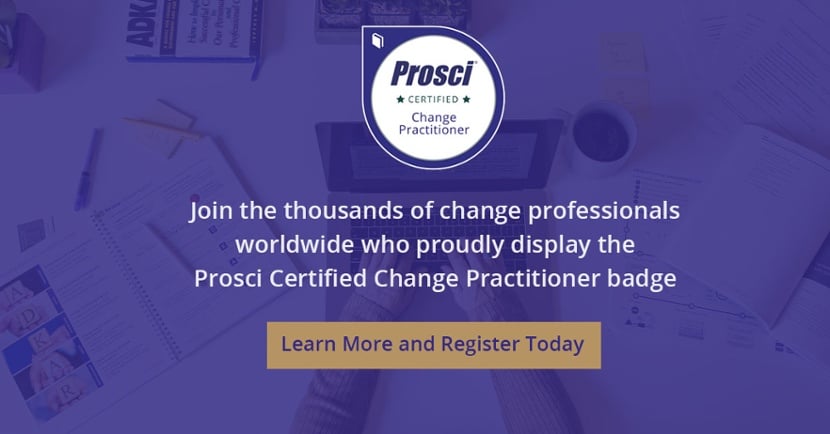Psychology of Change: Building Change-Ready Organizations

7 Mins
Updated: February 2, 2025
Published: February 1, 2024

Employees often feel anxious about change. For an organizational change to be successful, leaders and practitioners should focus on the psychology of change and then use these concepts to motivate and encourage employees to adopt a new way of working.
They must understand the psychological aspects of how change affects workers and then create strategies to engage employees to embrace change at a cultural level.
In this article, we’ll explore the psychology of change management and provide tips on creating a culture of change that consistently delivers desired outcomes.
The People Side of Change
Many organizations make the mistake of solely focusing on the technical side of change, such as timelines, milestones and deliverables. But even the most well-planned projects can fail when employees don’t adopt the change.
Whether it's new systems, policies or technologies, implementing change requires individuals to move from the current state to the future state. Employees must be guided and supported through the transition with easily accessible knowledge, resources and tools.
Prosci Unified Value Proposition

It's vital to involve employees in the planning, implementation and problem-solving stages of change. They need to clearly understand their role in reaching strategic goals.
Employees who stay in the dark about a change can become anxious and insecure about their roles and future at the company. This can lead to resistance and, consequently, failed change.
Organizations need effective change management to prepare, equip and support people during change and increase the likelihood of project success.
The Psychological Barriers To Change
Prosci defines resistance as the psychological and physiological reactions to change. Resistance is a natural and common response to change, as it can be deeply rooted and occur at both unconscious and conscious levels.
Many psychological factors can make employees and stakeholders resistant to change, including:
Confirmation bias
This psychological phenomenon concerns the human tendency to selectively seek information that supports our existing beliefs or initial impressions. This tendency is most potent with deeply held beliefs about “the way we do things around here.”
Loss aversion
As humans, we tend to prefer avoiding losses to acquiring equivalent gains. In fact, studies have shown that losses are twice as consequential psychologically as gains. Loss aversion can make us respond too quickly to the announcement of a shift in our way of working or even defer our decisions to engage, adopt and use that new way of working.
Endowment effect
Psychology shows that people are more likely to want to keep an object they already own than to acquire the same thing (if they don't own it). This is known as the Endowment Effect. It relates to loss aversion because giving up a well-established way of working can feel like a loss.
Ego
From a psychological point of view, most people don't know how little they know. Combining that with confirmation bias and anchoring—disproportionately relying on the first information you have about something—can become a potent source of resistance to change.
Social proof
People assimilate to group beliefs, actions or ideas they like or trust. This is reflected in sociologist Everett Rogers’ concept of "watching while being watched." Rogers theorized the Innovation Adoption Curve, where people adopting innovations or new ideas fit into five categories:
- Innovators – Explore the newest innovations and opportunities to be role models for change.
- Early adopters – Focused on the potential benefits and embrace change early despite the risks. They tend to be opinion leaders.
- Early majority – Adopt the change over time when performance and reliability are established.
- Late majority – Approach change with high skepticism and adopt change after the majority.
- Laggards – Highly averse to change and the last to adopt it, often only when forced
Rogers' Adoption Curve
 Illustration originally published in
Illustration originally published in
Change Management Field Notes by Al Lee-Bourke
As the model shows, people choose whether to adopt an innovation based on how they feel about the groups before them—while those behind them on the curve are looking ahead to them. That’s the heart of adoption.
Individuals in each phase have different resistance levels. When a mismanaged change occurs, employees look at the group before them and increase their resistance behaviors—while those already adopting the change start to second-guess or revert to old ways.
Using Change Management To Form Positive Change Mindsets
Psychological models help us understand how change affects people. Leaders and change professionals must use these insights to develop a successful change management model that avoids ego traps, overcomes potential obstacles, and drives desired outcomes.
1. It's all about the individual
Change is incredibly personal. Organizational change is the sum of individual changes and making personal decisions to engage in, adopt and use a new way of working.
As psychologist Carl Jung said, "Even when I'm dealing with empirical data, I'm necessarily talking about myself.”
Understanding the impact of change helps focus on the individual level of change and define what adoption and usage look like.
Prosci research outlines the 10 Aspects of Change Impact. These are the elements of a person's job that can be affected by an organizational change. Although not every change impacts every area, assessing all of them reveals where individuals and groups will need support.
When addressing these impacts on people, leaders and change professionals must focus on answering key questions: “Why should I change?” and “What's in it for me to change?”
Our ADKAR® Model is an individual change model you can use to help people adopt important changes. ADKAR stands for its five elements or stages: Awareness, Desire, Knowledge, Ability and Reinforcement.
The model's first stage, Awareness, is about understanding the need for change. Once you help a person build awareness, it's no longer a barrier to change. They can successfully move forward to the Desire stage (and eventually through all five stages).
Prosci ADKAR Model

2. Focus on the results and benefits
Ultimately, our perception of any experience, good or bad, is based on what happens at its peak and what happens at its end. It's a cognitive bias we all have, which the Nobel Prize winner, Daniel Kahneman, found in his research.
In change management, although organizational goals may be laudable, not everyone will subscribe to them and change how they work for the common good. Again, we must focus on “What's in it for me?” to help individuals adopt and use the change personally.
The Desire element of our ADKAR Model is about helping a person decide to participate in and support a change. You can often accomplish this by highlighting a change's potential benefits. Building desire motivates sponsors to fulfill their roles, mitigates resistance behaviors, and drives employee engagement during a change.
Change management can also fuel social proofing and adoption by simulating identity or helping people find their intrinsic and extrinsic motivations concerning the change.
3. Lead by example
Employees tend to mirror the behaviors of leaders, role models, and trusted colleagues. When senior leaders, managers and supervisors demonstrate desired behaviors and visibly guide a change, employees are more likely to participate in it.
Sponsors, or leaders who authorize and take responsibility for a change, play a vital role by making strategic decisions, collaborating with the project management and change management professionals, acquiring budget and human resources, and maintaining peer support.
These factors highlight why effective sponsorship is the leading contributor to successful change. A structured approach like the Prosci Methodology offers a robust and proven way to enable leaders to succeed in their roles.
Contributors to Success Over Time

4. Communicate effectively
Bigness bias is based on the observation that people pay more attention to big than small numbers. In change management, we see this when end users get stuck due to many tactical changes. They might fail to appreciate how all those tactical changes contribute to more significant strategic change.
We must ensure people aren’t overwhelmed by change and clearly understand how the tactical changes contribute to the overall change.
We accomplish this through effective communication, enabling the right people to deliver the correct information through preferred channels. Senior managers and leaders should supply the "high and why" messages. In contrast, people managers send the “What's in it for you, what's it to me?” messages, ultimately recognizing that no one knows everything.
Strong communication clarifies how employees impact a change through their work. Consistent communication can also clear doubts and help them focus on the benefits of a change.
5. Develop the required skills
Research shows that 40% of employees feel anxious about change. Most fear and anxiety about change come from employees who feel they lack the skills required to flourish in the new system. However, organizations can alleviate these fears and create a supportive environment using comprehensive training programs.
Share your expectations about performance and then provide training so they can develop the needed skills. Change professionals must allocate time and resources for training.
You can't expect employees to develop skills to apply new tools in one session. Instead, break down training programs into multiple sessions. Offer adequate time between sessions for employees to absorb new information and apply methods, systems or policies.
The Knowledge and Ability elements of ADKAR focus on building the understanding of how to change and then developing skills to demonstrate the change in practice.
6. Provide support
Change management professionals prepare and equip key for success during change. This includes providing clarity, training and resources. However, many initiatives fail because people managers at different levels are not prioritized. Our research shows that mid-level managers are the most resistant to change.
Most Resistant Groups

This is particularly important because people managers play a key role in supporting their own teams through a change, including as resistance managers. They can't be effective if they still resist the change themselves.
Mitigate manager resistance by involving them early in the change and helping them through their own ADKAR journeys.
Practitioners can engage with and support people managers by communicating their roles, holding meetings to ensure alignment, and providing materials and tools to help them navigate the change.
7. Reinforce changes
People naturally revert to familiar ways. If you can’t sustain the change, it becomes a superficial hift, and employees will revert to old systems, processes and work habits.
Organizations must plan and allocate resources for reinforcement activities, instead of immediately moving on after it goes live. Reinforcement activities are geared towards motivating and ensuring that employees stick to the new required behaviors.
Common reinforcement tactics include celebrations for reaching project milestones, rewards and recognition, two-way feedback mechanisms, and corrective actions for undesired behaviors.
These reinforcement activities must align with organizational management and operational processes, reporting structures, and measurement procedures. This increases employee understanding and makes it easier to seamlessly integrate the change with daily operations.
This also helps change teams and networks across different areas of a business align while setting clear guidelines for accountability and measuring performance.
8. Create a culture of change
Priming is a concept based on the fact that exposure to one stimulus influences how a person responds to a related stimulus later. Our brains are adapted to process information more readily after being exposed to something related.
We can use this in change management by developing an all-pervasive culture around the change using multiple, frequent and small stimuli related to the change. Research tells us that images, taglines, mission statements, posters, logos and branding are all great ways to achieve priming.
That might generate a propensity to process the change more readily as the project progresses.
Organizations can build a culture of change, where employees become resilient and view change as an opportunity, by enrolling in expert-led training programs and working with Prosci Advisory Services.
Change Management, Psychology and Prosci
People can change when they feel secure, motivated, informed and supported. Understanding why people change is crucial for creating and implementing effective change management strategies. By using insights from psychology, leaders and practitioners can design approaches that connect with employees' motivations and address their concerns.
Applying the psychology of change helps people engage with, adopt and maintain new ways of working. And that drives more successful project outcomes—because organizations change one person at a time.


